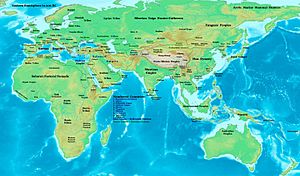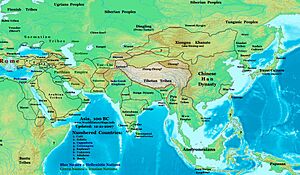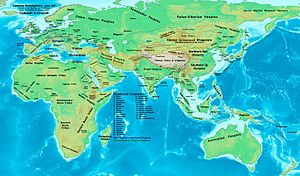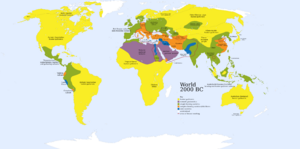Outline of ancient India facts for kids



Ancient India covers a huge part of history on the Indian subcontinent. It stretches from the earliest times, even before written records, up to the beginning of the Middle Ages. This period usually ends around 500 CE, which is when the Gupta Empire started to decline. During this long time, many amazing civilizations and empires rose and fell, shaping the culture and knowledge we know today.
Contents
What was Ancient India?
Ancient India refers to the vast and fascinating history of the Indian subcontinent, stretching from the very first human settlements all the way up to the beginning of the Medieval period, which is usually around 500 CE (that's Common Era, or what used to be called AD). It's a huge span of time, filled with incredible discoveries, powerful empires, brilliant thinkers, and amazing cultures that still influence the world today! Think of it as the foundational chapters of a very long and exciting book about one of the oldest civilizations on Earth.
A Journey Through Time: The Ages of Ancient India
Ancient India's history is like a giant puzzle with many pieces, each representing a different time period and culture. Let's explore them!
1. Pre-history: The Dawn of Civilization (c. 8000–3500 BCE)

Imagine a time long, long ago, even before writing was invented! This is the Pre-history of India, also known as the Neolithic Age. People were learning how to farm, domesticate animals, and build the first permanent homes.
- Indian Pre-history Age (c. 10,000–3300 BCE): This period saw early humans settling down and beginning to shape their environment.
- Bhirrana culture (7570–6200 BCE): One of the earliest known farming communities, showing how people started growing food instead of just hunting and gathering.
- Mehrgarh culture (c. 7000 – c. 2500 BCE): Located in what is now Pakistan, Mehrgarh was a very important early farming village. People here grew barley and wheat, raised cattle, and even made pottery! It shows us how early people started to build communities.
2. Proto-history: The Bronze Age and Great Cities (c. 3500–1800 BCE)
This era is called the Bronze Age because people learned to mix copper and tin to make bronze, a stronger metal for tools and weapons. This period also saw the rise of India's "first urbanization" – meaning people started living in big, planned cities!
- Indus Valley Civilization (c. 3300 – c. 1300 BCE): This is one of the most amazing ancient civilizations! Cities like Harappa and Mohenjo-Daro were incredibly well-planned, with straight streets, advanced drainage systems, and even public baths. People traded with distant lands, used a mysterious script we still can't fully read, and created beautiful pottery and seals. It was a truly advanced society for its time.
- Ahar–Banas culture (c. 3000 – c. 1500 BCE): This culture existed in what is now Rajasthan, known for its distinctive pottery and copper tools.
- Ochre Coloured Pottery culture (c. 2600–1200 BCE): Found in the Ganges plain, this culture is known for its reddish-orange pottery.
- Cemetery H culture (c. 1900–1300 BCE): This culture followed the mature phase of the Indus Valley Civilization, showing changes in burial practices and pottery styles.
3. Iron Age: New Tools and Early Kingdoms (c. 1800–200 BCE)

During the Iron Age, people discovered how to work with iron, which was even stronger and more common than bronze. This led to better tools for farming and warfare, helping new kingdoms and ways of life to develop.
- Vedic civilization (c. 1700 – c. 600 BCE): This period is named after the Vedas, ancient sacred texts that tell us a lot about the people, their beliefs, and their way of life. Society was organized into tribes and then into small kingdoms.
- Early Pottery Cultures: Cultures like the Black and Red Ware (c. 1500–700 BCE) and Painted Grey Ware (c. 1200 or 700–300 BCE) show how different groups of people lived and made their unique pottery. The Northern Black Polished Ware (c. 1200–500 BCE) was a very fine and shiny pottery, showing advanced craftsmanship.
- First Kingdoms: We see the emergence of early kingdoms like the Brihadratha dynasty (c. 1700 – c. 682 BCE), Gandhara Kingdom (c. 1500 – c. 545 BCE), and the Kuru kingdom (c. 1200 – c. 345 BCE). In the south, the Pandyan Kingdom (c. 600 BCE – c. 650 CE) began its long and influential history.
4. Pre-Classical Period: Empires Rise (c. 600 BCE–200 CE)
This period saw the rise of larger and more powerful empires that united many smaller kingdoms.
- Magadha Dynasties: Several dynasties, like the Haryanka (c. 544–413 BCE) and Shaishunaga (c. 413–345 BCE), ruled the powerful kingdom of Magadha, which became a center of power.
- Nanda Empire (c. 345 – c. 322 BCE): This was a very large and powerful empire, known for its vast army.
- Maurya Empire (c. 322–185 BCE): This was one of the largest empires in ancient India, founded by Chandragupta Maurya. Its most famous ruler was Emperor Ashoka the Great. He initially expanded the empire through conquest but later became a follower of Buddhism and promoted peace and kindness throughout his vast kingdom. He built many stupas (dome-shaped shrines) and pillars with his messages carved on them.
- Southern Kingdoms: The Sangam period (c. 300 BCE – c. 300 CE) in South India was a time of great literary and cultural flourishing, with powerful kingdoms like the Chera (c. 300 BCE–1102 CE) and Chola (c. 300 BCE–1279 CE) alongside the Pandyan Kingdom.
- Other Important Empires: The Satavahana Empire (230 BCE–220 CE) in the Deccan region was known for its trade and maritime activities. The Kushan Empire (30–375 CE) was a powerful empire that connected India with Central Asia and China, playing a big role in trade along the Silk Road.
5. Classical Period: The Golden Age (c. 200–550 CE)
Many historians call this the "Golden Age" of Ancient India because there were so many amazing advancements in science, art, literature, and philosophy.
- Gupta Empire (c. 320–650 CE): This empire is famous for its peace, prosperity, and incredible achievements. During the Gupta period, mathematicians invented the concept of zero and the decimal system, astronomers made important discoveries about the Earth and stars, and artists created beautiful sculptures and paintings. Literature, especially Sanskrit plays and poetry, also flourished.
- Other Powerful Dynasties: Alongside the Guptas, other important kingdoms like the Vakataka Empire (c. 250 – c. 500 CE) and the Pallava Empire (c. 275–901 CE) in the south also made significant contributions to art and architecture, especially temple building. The Kadamba dynasty (c. 345–1347 CE) and Western Ganga dynasty (c. 350–1024 CE) were also influential.
Ancient Indian Culture
Ancient India wasn't just about kings and empires; it was also a vibrant hub of culture, ideas, and creativity!
Art in Ancient India
Ancient Indians were incredible artists! They created beautiful sculptures, paintings, and architecture. Music was also very important, with traditions like Carnatic music and Hindustani music having roots in these ancient times. Imagine listening to melodies that have been passed down for thousands of years!
Languages and Scripts in Ancient India
Language was key to sharing knowledge and stories.
- Vedic Sanskrit: This is one of the oldest known languages and the language of the Vedas. It's the ancestor of many modern Indian languages.
- Old Tamil: A very ancient language spoken in South India, with a rich literary tradition from the Sangam period.
- Ancient Scripts: People developed many ways to write, including Brahmi (from which many Indian scripts evolved), Tamil-Brahmi, Pallava script, and the elegant Gupta script.
Beliefs and Ideas (Religion) in Ancient India
Ancient India was a birthplace of several major belief systems that have shaped the world.
- Hinduism: One of the oldest religions in the world, Hinduism has roots in the Vedic period. It involves a rich tapestry of gods, goddesses, philosophies, and rituals, emphasizing dharma (righteous conduct) and karma (the idea that your actions have consequences).
- Jainism: Founded by Mahavira, Jainism emphasizes non-violence towards all living beings, self-control, and spiritual purity.
- Buddhism: Founded by Siddhartha Gautama (the Buddha), Buddhism teaches about suffering, the path to enlightenment, and the importance of compassion and mindfulness. Emperor Ashoka played a huge role in spreading Buddhism.
These ancient belief systems encouraged people to think deeply about life, morality, and the universe.
Science and Technology in Ancient India
Ancient Indians were not just artists and philosophers; they were also brilliant scientists and innovators!
Indian Mathematics: They made groundbreaking contributions, including the invention of the decimal system (using place values for numbers) and the concept of zero, which are fundamental to mathematics worldwide today! Imagine trying to do math without zero! Indian Astronomy: Ancient Indian astronomers studied the stars and planets, calculated the circumference of the Earth, and understood that the Earth rotates on its axis and revolves around the sun long before many others. Ancient Indian Medicine: Systems like Ayurveda and Siddha medicine developed sophisticated understandings of the human body and natural remedies, focusing on balance and holistic well-being. Architecture: They built magnificent structures, from the planned cities of the Indus Valley to the rock-cut caves and grand temples, like those in the Dravidian architecture style of South India. Indian Martial Arts: Ancient India also developed various forms of martial arts, such as Malla-yuddha (an ancient form of wrestling) and Kalaripayattu (one of the oldest known martial arts, from Kerala).
Where to See Ancient India Today: Museums
Even though Ancient India was thousands of years ago, you can still see amazing artifacts and learn more about it in museums around the world!
In India: The National Museum in New Delhi, the Indian Museum in Kolkata, and the Government Museum in Bangalore are just a few places where you can see ancient pottery, sculptures, tools, and more. In the United Kingdom: The British Museum in London also has a wonderful collection of ancient Indian exhibits.
Ancient India was a truly remarkable period, laying the groundwork for much of the culture, science, and philosophy that followed. It's a testament to human ingenuity and creativity that continues to inspire us today.
See also
 In Spanish: Historia de la India para niños
In Spanish: Historia de la India para niños


